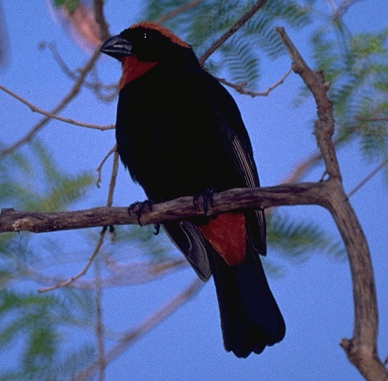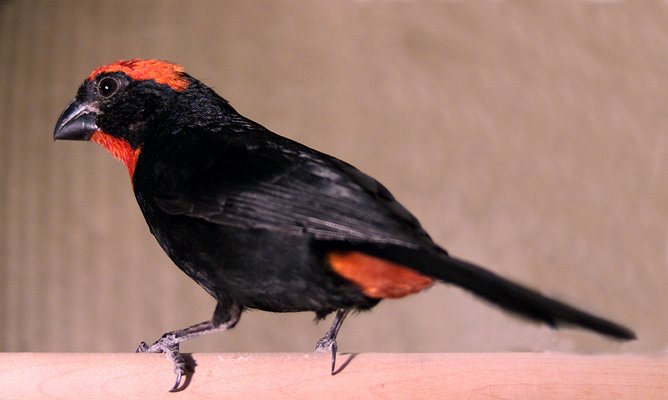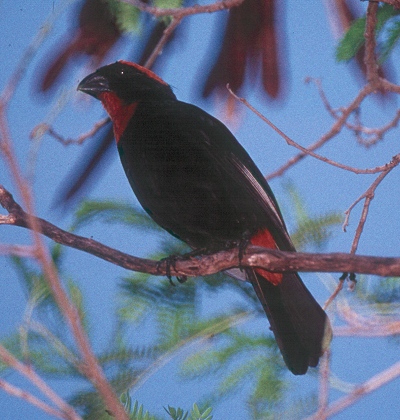|
Puerto Rican Bullfinch Loxigilla portoricensis Comeñame,
|
 |
|
Photo: M. Oberle
|
|
Puerto Rican Bullfinch Loxigilla portoricensis Comeñame,
|
 |
|
Photo: M. Oberle
|
|
IDENTIFICATION: A thick-billed, black, forest bird with large reddish patches above the eyes, on the throat, and under the base of the tail. The female is slightly smaller and duller colored than the male. Length: 17-19 cm.; weight: 32-33 g. VOICE: The song is a series of rich, whistled notes followed by a high-pitched trill (somewhat like the song of the Northern Cardinal, Cardinalis cardinalis, of North America). The trill portion of the song may not be audible from a distance or in dense vegetation. Audio (M. Oberle). The Bullfinch often sings at any time of day while hidden in dense or treetop vegetation. It also has a low "tsweet" note. HABITAT: Moist and dry forests with thick undergrowth, thick brushy areas, and coffee plantations throughout the island, except the far eastern end. HABITS: Feeds on fruits and seeds, and less commonly on plant shoots, buds, flowers and nectar. It forages in dense vegetation at any level in the forest, but mostly at middle levels in moist forest, and in the canopy of dry and elfin forests. It prefers outer branches of trees and shrubs. It will pause on one perch and carefully inspect its immediate surroundings for food before moving on to the next perch. It sometimes leans off a branch until it is almost hanging, in order to reach an attractive cluster of fruit. At least 41 species of plants have been identified in its diet, including fruits of camasey, sierra palm, and psycotria. Its thick bill allows the bullfinch to eat seeds too large or tough for other birds. Insects (caterpillars, weevils, other beetles, wasps), snails, and spiders made up about 1/3 of the diet in one study. The Bullfinch will forage alone, or in pairs, sometimes in small, mixed-species flocks. It feeds intensively in the morning and early afternoon, and will drink water from pools on the ground or from bromeliads and other plants. It is quite often seen as it rapidly flies low across a forest clearing or road. It makes a globular nest with a side entrance. A typical clutch contains three light green, spotted eggs. STATUS AND CONSERVATION: Common in appropriate habitat, but it is more often heard than seen. RANGE: Endemic to Puerto Rico. Regular in woodlands throughout the island, such as at El Yunque, and at Vega, Carite, Guajataca, Maricao and Guánica State Forests. TAXONOMY: PASSERIFORMES; EMBERIZIDAE. The Puerto Rican form had been considered as a subspecies (Loxigilla portoricensis portoricensis), with a slightly larger subspecies (Loxigilla portoricensis grandis) found 170 miles to the east on St. Kitts. The St. Kitts form is now considered a separate species from the Puerto Rican form, but is thought to have disappeared about 1929. Two closely related species occur in the Caribbean: the Greater Antillean Bullfinch (Loxigilla violacea) on Hispaniola, Jamaica, the Bahamas, and Turks and Caicos; and the Lesser Antillean Bullfinch, (Loxigilla noctis) in the eastern Caribbean. The latter species has been expanding its range westward and is now common in the Virgin Islands. |
|
 |
|
|
Photo: M. Oberle*
|
 |
|
Photo: M. Oberle
|
 |
|
Photo: M. Oberle
|
 |
|
Photo: M. Oberle
|
 |
|
Photo: M. Oberle
|
 |
|
Photo: M. Oberle
|
 |
|
Photo: C. Ruiz*
|
|
References Carlo, T. 1999. Alimentación de las aves terrestres de Puerto Rico. El Bien-te-veo 2(2):2. Carlo, T. A., Collazo, J. A., and M. J. Groom. 2003. Avian fruit preferences across a Puerto Rican forested landscape: pattern consistency and implications for seed removal. Oecologia 134:119-131. Cruz, A. 1980. Avian feeding assemblages in Puerto Rico. Carib. J. Sci. 15:21-27. Cruz, A. 1987. Avian community organization in a mahogany plantation on a Neotropical island. Carib. J. Sci. 23:286-296. Garrido, O. H. and J. W. Wiley. 2001. The taxonomic status of the Puerto Rican Bullfinch (Loxigilla portoricensis) [Aves: Emberizidae] in Puerto Rico and St. Kitts. El Pitirre 14(2):76. Garrido, O. H. and J. W. Wiley. 2003. The taxonomic status of the Puerto Rican Bullfinch (Loxigilla portoricensis) (Emberizidae) in Puerto Rico and St Kitts. Orn. Neotrop. 14: 91-98. Greenlaw, J. S. 1990. Foraging behavior in Loxigilla bullfinches, with special reference to foot-holding and to nectar-robbing in the Lesser Antillean Bullfinch. Carib. J. Sci. 26:62-65. Pérez-Rivera, R. A. 1993. Notes on breeding of the Puerto Rican Tanager (Nesospingus speculiferus). Carib. J. Sci. 29:262-264. Pérez-Rivera, R. A. 1994. Feeding ecology of the Puerto Rican Bullfinch (Loxigilla portoricensis) in the Carite and Guánica forests. Carib. J. Sci. 30(3-4):242-249. Pérez-Rivera, R. A. and E. N. Dechoudens. 1996. Use of bird nests by Eleutherodactylus frogs in the Carite forest, Puerto Rico. Carib. J. Sci. 32:201-205. Raffaele, H.A. 1989. A guide to the birds of Puerto Rico and the Virgin Islands. Princeton. Raffaele, H.A. 1989. Una guía a las aves de Puerto Rico y las Islas Vírgenes. Publishing Resources, Inc., Santurce, PR. Raffaele, H.A., J.W. Wiley, O.H. Garrido, A.R. Keith, and J.I. Raffaele. 1998. Guide to the birds of the West Indies. Princeton. Recher, H.F. and J. T. Recher. 1966. A contribution to the knowledge of the avifauna of the Sierra de Luquillo, Puerto Rico. Carib. J. Sci. 6:151-161. Wunderle, J.M., A. Díaz, L. Velasquez, and R. Scharrón. 1987. Forest openings and the distribution of understory birds in a Puerto Rican rainforest. Wilson Bull. 99:22-37. Puerto Rican Bullfinch, Spanish text Next endemic species in taxonomic order Previous endemic species in taxonomic order |
|